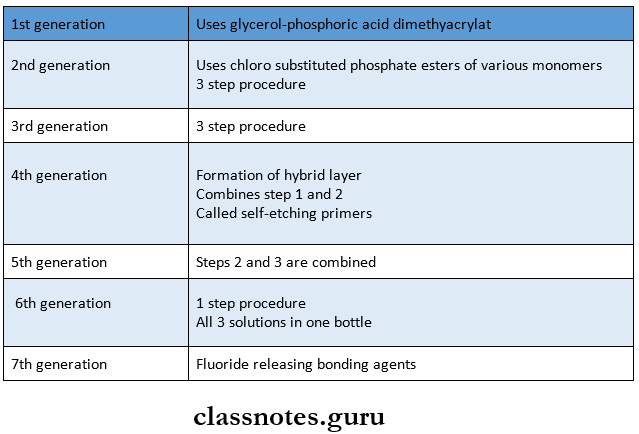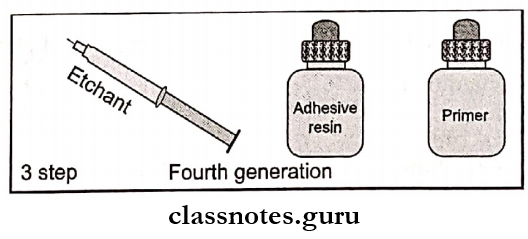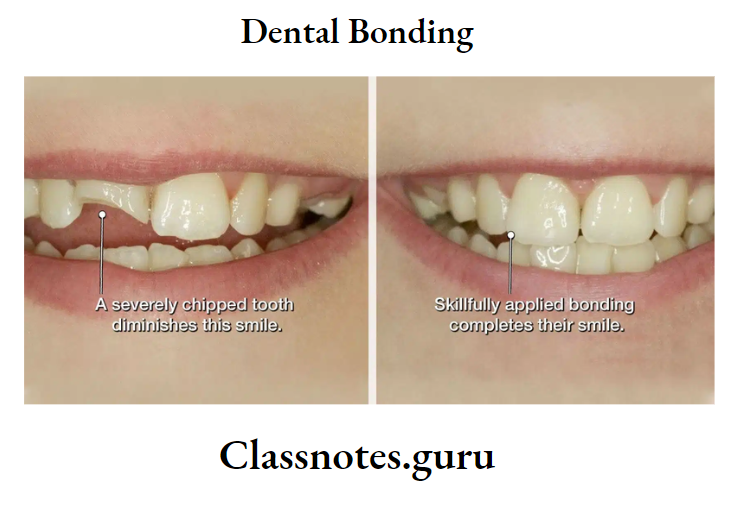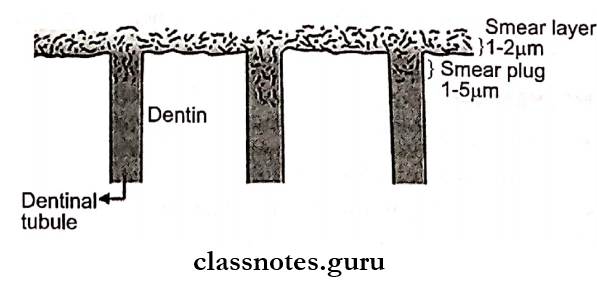Bonding Important Notes
1. Bonding Systems
- Enamel bonding system
- Dentin bonding system
- Amalgam bonding system
2. Enamel Bonding System
- Consist of unfilled liquid acrylic BIS-GMA resin monomer mixture placed onto acid etched enamel
- Steps:
- Acid etching by 37% phosphoric acid
- Results in the formation of resin tags
- A concentration greater than 50% results in the formation of monocalcium phosphate monohydrate that prevents further dissolution
- Below 30% results in the formation of dicalcium phosphate dehydrate that cannot be easily removed
- The length of application of the etchant is 15 seconds
- Increased in fluoride-treated teeth and primary teeth
- Etched enamel is rinsed with water for 20 seconds
- Next enamel bonding agent is applied to the etched surface
- Acid etching by 37% phosphoric acid
3. Dentin Bonding System
- Consist of unfilled liquid acrylic BIS-GMA resin monomer mixture placed onto acid-conditioned dentin surface
- Dentin bonding is difficult because
- Dentin tissue contains plenty of fluids
- Presence of a smear layer
- Chemical effects on the pulp
- Steps:
- Step 1 – Etching/ conditioning
- Conditioners are agents that aid in the removal or modification of the smear layer
- Step 2- Application of primer
- Primers are hydrophilic monomers which are applied over the etched surfaces for easy flow of bonding agents
- Step 3 – Application of bonding agent
- Dentin bonding agents are unfilled resins that help in the formation and stabilization of hybrid layer
- Step 1 – Etching/ conditioning
4. Amalgam Bonding Systems
- Amalgam Bonding Systems is used to bond
- Amalgam to tooth
- Amalgam to amalgam
- Amalgam to other metal substrates
5. Dentin Bonding Agents – Generations

6. Bond Strength Of Various Bonding Systems

Read And Learn More: Operative Dentistry Short And Long Essay Question And Answers
Bonding Short Essays
Question 1. Acid etching.
Answer:
Acid Eetching:
- Acid etching is the process of increasing the surface reactivity by demineralizing the superficial calcium layer and thus creating enamel tags.
- These tags help in micro-mechanical bonding between the tooth and restorative resin.
Acid etching Mechanism:
- Cleanses debris
- Increases enamel surface area
- Produces micropores for mechanical interlocking
- Exposes more reactive surface layer

Factors Affecting It:
- Form of acid-gel
- The concentration of acid – 37% phosphoric acid
- Time – 15-20 sec.
- Chemical nature of enamel
- Type of dentition
Acid etching Technique:
- Oral prophylaxis
- Isolate the tooth
- Application of etchant for 15 seconds
- Rinse thoroughly for 5-10 seconds
- Dry it which results in a frosty, white appearance
- Apply enamel bonding agents
Question 2. Dentin Bonding agents.
Answer:
Bonding Agents:
- Denting bonding agents have both hydrophilic and hydrophobic ends
- The hydrophilic end displaces dentinal fluid while the hydro-phobic end bonds to the composite resin



Bonding Short Answers
Question 1. Hybridization.
Answer:
Hybridization:
- Given by Nakabayachi
- Hybridization is a process of the formation of resin
- Important in micromechanical bonding
- Conditioning the dentinal surface exposes the collagen fibrin network with microporosities
- These spaces are filled with low-viscosity monomers when the primer is applied.

Question 2. Hybrid Layer.
Answer:
Hybrid Layer:
- The layer formed by the demineralization of dentin infiltration of monomer and subsequent polymerization is called a hybrid layer
Zones:
1. Top Layer – Loosely arranged collagen fibrils
- Interfibrillar spaces filled with resin
2. Middle Layer – Replacement of hydroxyapatite crystals by resin monomer
3. Bottom Layer-Unaffected dentin
Question 3. Smear Layer.
Answer:
Smear Layer:
Definition:
- Smear Layer is defined as any debris calcific in nature, produced by reduction or instrumentation of enamel, dentin, or cementum.
- Depth – 1-5 pm
Components:
- Inorganic:
- Tooth Structure
- Nonspecific inorganic contaminants
- Organic:
- Coagulated proteins
- Necrotic pulp tissues
- Saliva, blood cells
- Micro-organism
- Role:
- The physical barrier for bacteria
- Diffusion of molecules
- Resistance to fluid movement

Question 4. Types and Definition of Adhesion.
Answer:
Definition Of Adhesion:
- Adhesion refers to the forces between atoms of two unlike substances when placed in intimate contact with each other
Adhesion Types:
- Micromechanical – By formation of resin tags
- Adsorption – Chemical bonding
- Diffusion – Precipitation of substances
- Combinations
Question 5. Objectives of Acid Etching.
(or)
Effects of acid etching on Enamel
Answer:
Objectives Of Acid Etching:
- Creates microporosity in the enamel
- Increases surface area of enamel
- Results in the selective dissolution of enamel
- Formation of resin tag through the penetration of resins
- Forms a mechanical bond to the enamel
- Allows the wetting of tooth surface with resin
Question 6. Self-Etching Primers.
Answer:
Self-Etching Primers:
- These are sixth-generation dentinal adhesives
- Etchant and primes are in the same bottle while the adhesive resin is in other
- Easy to manipulate
- Good bond strength to dentin
- Example. Prompt L-Pop
Bonding Viva Voce
- After etching, the surface area increases up to 2000 times that of the original untreated surface
- Maleic acid, citric acid, and oxalic acid are used to etch enamel and dentin
- The bonding agent enhances the wettability of composites to etched enamel
- Resin tags between enamel rod peripheries are called macro tags
- Resin tags across the end of each rod are called micro tags
- Length of micro tags – 2-5 mm
- Most composites are hydrophobic
- 2-HEMA and HEMA dissolved in acetone or alcohol are used as primers
- Cast restorations bonding system uses luting cement
- Buonocore discovered acid etching
